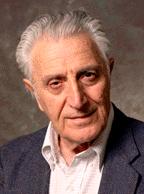Laudatio
2004
Awarded
Contribution:
E.
L. Hahn, Spin Echoes, Bull. Am. Phys. Soc. 24, No. 7, 13 (1949),
reprinted in Phys. Rev. 77, 746 (1950).
(This is the abstract for a
ten minutes presentation to be given at the Chicago
meeting of the American Physical Society on November 25, 1949.)
The
Prize Winner:

|
Erwin
L. Hahn,
Professor Emeritus,
University of California,
Berkeley,
USA.
|
The
Technologies:
The
awarded contribution contains several original ideas and results that
have had a strong impact on modern NMR technology, notably
- the two pulse spin echo that still is the method of choice for
e.g. refocusing chemical shift dephasings in pulse sequences,
not to mention widespread applications in MRI;
- the interpretation of spin echoes, where time (rather than
frequency) is used as the essential variable beyond the initial stage
of Bloch's theory of CW spectroscopy and of relaxation measurements:
this spin dynamics method was immediately essential for the
development of spin echo applications, and it is still today the
theoretical approach used for most NMR techniques;
- the experimental demonstration that the observation of NMR pulse
responses is a viable technology that can provide higher sensitivity
than CW spectroscopy.
The
awarded contribution clearly was the foundation for the more
extensive description of spin echoes in E. L. Hahn, Spin Echoes,
Phys. Rev. 80, 580-594 (1950), that was submitted six months after
the lecture at the Chicago meeting, where further high-impact ideas
related to spin echoes were presented:
- the study of molecular diffusion and bulk motion by observation
of their effects on the spin echoes: with minor modifications, this
is still the method of choice for accurate measurements of molecular
diffusion coefficients in liquids and for flow measurements in
general;
- the study of "secondary" spin echoes after three
pulses, another step towards multiple-pulse techniques;
- the observation of a modulation of the peak spin echo amplitudes
in some homonuclear spin systems and the conclusion that the
modulation cannot be explained by differences in chemical shifts,
hence that it indicates a new spin-spin coupling not averaged out by
molecular motion. This proved later to be J couplings. It also showed
that multiple-pulse spectroscopy provides important qualitative
information that was not directly available by CW techniques;
- the description and use of a coherent pulse spectrometer
including a CW reference oscillator at the NMR frequency, hence
control of the phase of the pulses and observation of the phase of
the spin responses: the basic elements of modern pulse spectrometers
are presented here for the first time.
|
